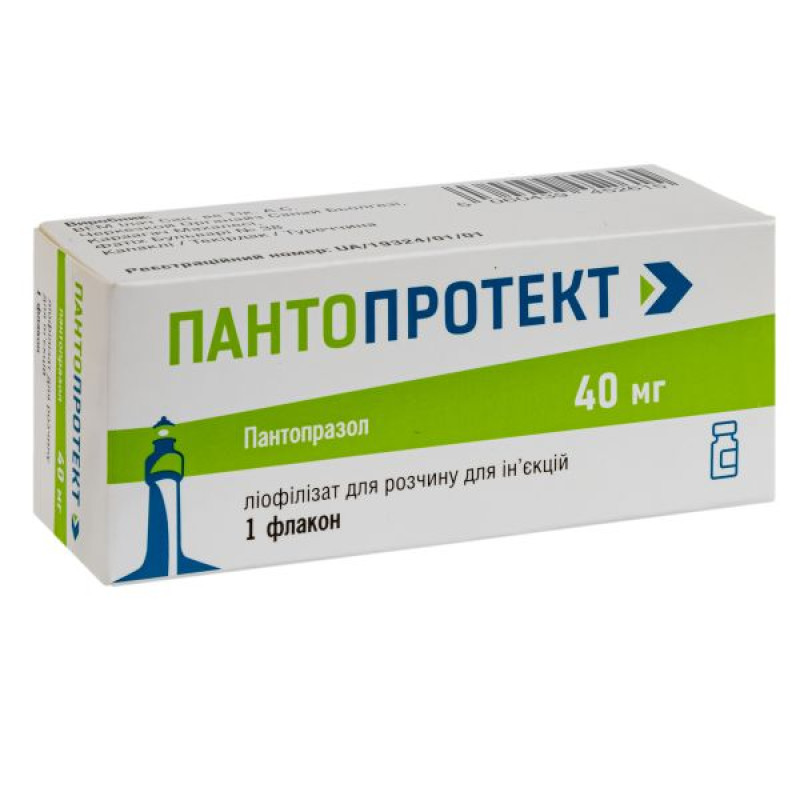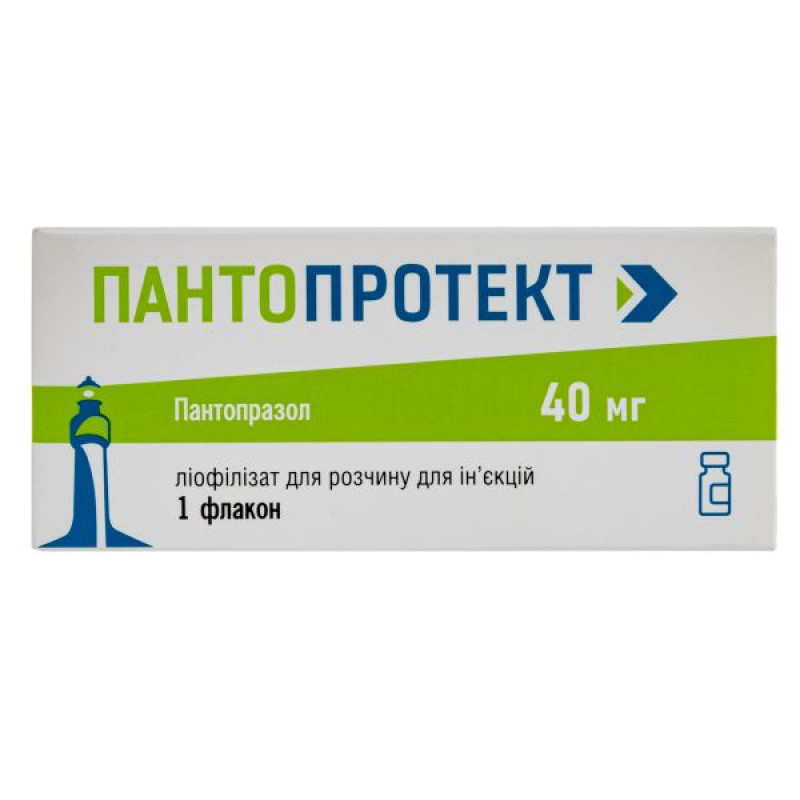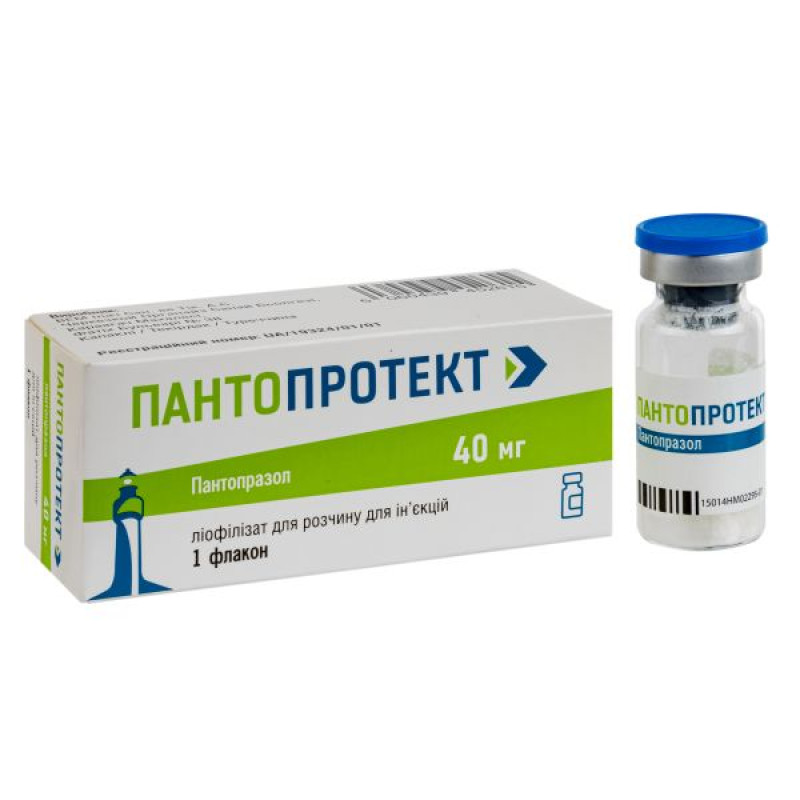Pantoprotect lyophilisate for solution for injection 40 mg vial No. 1

Instructions Pantoprotect lyophilisate for solution for injection 40 mg vial No. 1
Composition
active ingredient: pantoprazole;
1 vial contains 40.0 mg of pantoprazole (in the form of pantoprazole sodium sesquihydrate); excipients: sodium hydroxide, water for injections.
Dosage form
Lyophilisate for solution for injection.
Main physicochemical properties: lyophilized mass of white or almost white color.
Pharmacotherapeutic group
Drugs for the treatment of acid-dependent diseases. Proton pump inhibitors. Pantoprazole. ATC code A02B C02.
Pharmacological properties
Pharmacodynamics
Pantoprazole is a substituted benzimidazole that inhibits gastric acid secretion by specific blockade of the proton pumps of the parietal cells. Pantoprazole is converted to its active form in the acidic environment of the parietal cells, where it inhibits the enzyme H+-K+-ATPase, i.e. blocks the final step in the production of gastric acid. The inhibition is dose-dependent and affects both basal and stimulated acid secretion. In most patients, symptoms resolve within 2 weeks. The use of pantoprazole, like other proton pump inhibitors (PPIs) and H2-receptor inhibitors, reduces gastric acidity and thus increases gastrin secretion in proportion to the decrease in acidity. The increase in gastrin secretion is reversible. Since pantoprazole binds the enzyme distal to the cellular receptor, it can inhibit hydrochloric acid secretion regardless of stimulation by other substances (acetylcholine, histamine, gastrin). The effect is the same when the drug is administered orally and intravenously.
Pantoprazole increases fasting gastrin levels. In short-term use, they do not exceed the upper limit of normal in most cases. In long-term treatment, gastrin levels are usually doubled. Excessive increases occur only in isolated cases. As a result, a slight to moderate increase in specific endocrine (ECL) cells in the stomach (similar to adenomatoid hyperplasia) is sometimes observed during long-term treatment. However, according to studies conducted to date, the formation of neuroendocrine tumor precursor cells (atypical hyperplasia) or neuroendocrine tumors of the stomach, which have been observed in animal studies, has not been observed in humans.
Based on the results of animal studies, an effect of long-term (more than one year) treatment with pantoprazole on endocrine parameters of the thyroid gland cannot be completely excluded.
During treatment with antisecretory drugs, serum gastrin levels increase in response to decreased acid secretion. In addition, chromogranin A (CgA) levels increase due to decreased gastric acidity. Elevated CgA levels may interfere with diagnostic tests for neuroendocrine tumors. Available published data suggest that proton pump inhibitor treatment should be discontinued for 5 days to 2 weeks before CgA measurements. This allows CgA levels, which may be falsely elevated after PPI treatment, to return to the normal range.
Pharmacokinetics
Pharmacokinetic properties do not change after single or repeated administration. In the dose range from 10 to 80 mg, the pharmacokinetics of pantoprazole in plasma remain linear both after oral and intravenous administration. Distribution. The binding of pantoprazole to serum proteins is about 98%. The volume of distribution is about 0.15 l/kg.
Biotransformation. The substance is metabolized almost exclusively in the liver. The main metabolic pathway is demethylation by CYP2C19 followed by sulfate conjugation; other metabolic pathways include oxidation by CYP3A4.
Elimination: The terminal half-life is about 1 hour and the clearance is 0.1 l/h/kg. Several cases of delayed elimination have been reported. Due to the specific binding of pantoprazole to the proton pumps of the parietal cells, the half-life does not correlate with the much longer duration of action (inhibition of acid secretion).
Poor metabolisers. Approximately 3% of Europeans have low functional activity of the CYP2C19 enzyme, known as poor metabolisers. In these individuals, the metabolism of pantoprazole is likely to be mainly catalysed by the CYP3A4 enzyme. After a single dose of 40 mg pantoprazole, the mean area under the plasma concentration-time curve was approximately 6 times larger in poor metabolisers than in subjects with functional CYP2C19 (extensive metabolisers). The mean peak plasma concentration was increased by approximately 60%. These findings do not affect the dosage of pantoprazole. Renal impairment. There is no recommendation for a dose reduction when prescribing pantoprazole to patients with reduced renal function (including patients on dialysis). As in healthy volunteers, the elimination half-life of pantoprazole is short. Only very small amounts of pantoprazole are dialysable. Although the main metabolite has a moderately long half-life (2–3 h), elimination is still rapid, so accumulation does not occur.
Hepatic impairment: Although in patients with cirrhosis (Child-Pugh classes A and B) the half-life increases to 7–9 hours and the AUC increases 5–7-fold, the maximum serum concentration increases only slightly, by 1.5-fold, compared with that in healthy volunteers.
Elderly patients: The slight increase in AUC and Cmax in elderly volunteers compared to younger volunteers is also not clinically relevant.
Children: After a single intravenous administration of pantoprazole at doses of 0.8 or 1.6 mg/kg to children aged 2 to 16 years, there was no significant relationship between the clearance of pantoprazole and the patient's age or body weight. The AUC and volume of distribution were consistent with those obtained in studies in adults.
Indication
Reflux esophagitis.
· Duodenal ulcer.
· Stomach ulcer.
Zollinger-Ellison syndrome and other hypersecretory pathological conditions.
Contraindication
Hypersensitivity to pantoprazole, benzimidazole derivatives or to any component of the drug.
Interaction with other medicinal products and other types of interactions
Medicinal products whose absorption is pH-dependent: Due to the complete and long-term inhibition of hydrochloric acid secretion, pantoprazole may affect the absorption of medicinal products for which the pH of the gastric juice is an important factor in their bioavailability (e.g. some antifungals such as ketoconazole, itraconazole, posaconazole, or other medicinal products such as erlotinib).
HIV protease inhibitors: Concomitant use of proton pump inhibitors with HIV protease inhibitors whose absorption depends on intragastric pH (such as atazanavir) is not recommended due to a significant reduction in their bioavailability (see section 4.4).
If concomitant use of HIV protease inhibitors with proton pump inhibitors cannot be avoided, close clinical monitoring (e.g. viral load) is recommended. The daily dose of pantoprazole should not exceed 20 mg. Dose adjustment of HIV protease inhibitors may be necessary.
Coumarin anticoagulants (phenprocoumon and warfarin). Concomitant use of pantoprazole with warfarin or phenprocoumon did not affect the pharmacokinetics of warfarin, phenprocoumon or INR (international normalized ratio). However, increases in INR and prolongation of prothrombin time have been reported in patients receiving concomitant PPIs and warfarin or phenprocoumon. Increases in INR and prolongation of prothrombin time may lead to pathological bleeding and even death. In such concomitant use, monitoring of INR and prothrombin time is necessary.
Methotrexate: Concomitant use of high doses of methotrexate (e.g. 300 mg) and proton pump inhibitors has been reported to increase blood levels of methotrexate in some patients. Patients receiving high doses of methotrexate, e.g. patients with cancer or psoriasis, are advised to temporarily discontinue pantoprazole treatment.
Other interactions. Pantoprazole is extensively metabolised in the liver via the cytochrome P450 enzyme system. The main metabolic pathway is demethylation by CYP2C19, other metabolic pathways include oxidation by CYP3A4. Studies with medicinal products also metabolised by these pathways, such as carbamazepine, diazepam, glibenclamide, nifedipine and oral contraceptives containing levonorgestrel and ethinylestradiol, have not revealed any clinically significant interactions.
Interactions of pantoprazole with other drugs that are metabolized by the same enzyme system cannot be excluded.
The results of a number of interaction studies indicate that pantoprazole does not affect the metabolism of active substances metabolized by CYP1A2 (e.g. caffeine, theophylline), CYP2C9 (e.g. piroxicam, diclofenac, naproxen), CYP2D6 (e.g. metoprolol), CYP2E1 (e.g. ethanol), and does not affect the p-glycoprotein-bound absorption of digoxin.
Studies of the interaction of pantoprazole with certain antibiotics when used simultaneously (clarithromycin, metronidazole, amoxicillin) have also been conducted. No clinically significant interactions between these drugs have been identified.
Medicinal products that inhibit or induce CYP2C19. CYP2C19 inhibitors, such as fluvoxamine, may increase the systemic exposure of pantoprazole. A dose reduction should be considered in patients receiving long-term high-dose pantoprazole therapy and in patients with impaired liver function. Inducers of enzymes that affect CYP2C19 and CYP3A4, such as rifampicin and St. John's wort (Hypericum perforatum), may reduce plasma concentrations of PPIs that are metabolised by these enzyme systems.
Application features
Gastric malignancies. Symptomatic response to pantoprazole may mask symptoms of gastric malignancies and delay their diagnosis. In the presence of alarming symptoms (e.g. significant weight loss, recurrent vomiting, dysphagia, haematemesis, anaemia, melena), as well as in the presence or suspicion of gastric ulcer, malignancy should be excluded. If symptoms persist despite adequate treatment, further investigation is necessary.
Hepatic impairment: In patients with severe hepatic impairment, liver enzymes should be monitored regularly. In case of increased liver enzymes, pantoprazole treatment should be discontinued (see section 4.2).
HIV protease inhibitors: Concomitant use of pantoprazole with HIV protease inhibitors (such as atazanavir) whose absorption is dependent on intragastric pH is not recommended due to a significant reduction in their bioavailability (see section 4.5).
Gastrointestinal infections caused by bacteria. Treatment with pantoprazole slightly increases the risk of gastrointestinal infections caused by bacteria such as Salmonella and Campylobacter or C. Difficile.
Hypomagnesemia: Severe hypomagnesemia has been reported in patients receiving PPIs such as pantoprazole for at least three months, in most cases for a year. The following serious clinical manifestations of hypomagnesemia may occur and may initially be insidious: fatigue, tetany, delirium, convulsions, dizziness and ventricular arrhythmias. In the case of hypomagnesemia, the condition of the patients improved in most cases after correction with magnesium preparations and discontinuation of the PPI. In patients requiring long-term therapy and in patients taking PPIs concomitantly with digoxin or drugs that may cause hypomagnesemia (e.g. diuretics), magnesium levels should be determined before starting PPI treatment and periodically during treatment.
Bone fractures: Long-term treatment (more than 1 year) with high doses of proton pump inhibitors increases the risk of hip, wrist and spine fractures, mainly in elderly patients or in the presence of other risk factors.
Observational studies suggest that proton pump inhibitor use increases the overall risk of fractures by 10–40%. Some of these may be due to other risk factors. Patients at risk of osteoporosis should receive treatment according to current clinical guidelines and consume adequate amounts of vitamin D and calcium.
Subacute cutaneous lupus erythematosus. The use of proton pump inhibitors has been associated with very rare cases of subacute cutaneous lupus erythematosus. If lesions occur, especially in areas of the skin exposed to sunlight, and this is accompanied by arthralgia, the patient should immediately consult a doctor who will consider the need to discontinue the use of Pantoprotect. The occurrence of subacute cutaneous lupus erythematosus in patients during previous therapy with proton pump inhibitors increases the risk of its development with the use of other proton pump inhibitors.
Influence on laboratory test results. Elevated levels of chromogranin A (CgA) may influence the results of tests used to diagnose neuroendocrine tumors. To avoid such an influence, treatment with Pantoprotector should be temporarily discontinued at least 5 days before the assessment of CgA levels (see section "Pharmacodynamics"). If CgA and gastrin levels have not returned to the normal range after the initial measurement, repeat measurements should be performed 14 days after discontinuation of proton pump inhibitor treatment.
Important information about excipients.
Sodium: This medicinal product contains less than 1 mmol (23 mg) sodium per vial, i.e. essentially ‘sodium-free’.
Use during pregnancy or breastfeeding
Breast-feeding. Animal studies have shown excretion of pantoprazole in breast milk. There is insufficient information on the excretion of pantoprazole in human milk, but such excretion has been reported. A risk to the newborn/infants cannot be excluded. A decision on whether to discontinue breast-feeding or to discontinue/abstain from Pantoprotect therapy should be made taking into account the benefit of breast-feeding for the child and the benefit of therapy for the woman. Fertility. Pantoprazole did not impair fertility in animal studies.
Ability to influence reaction speed when driving vehicles or other mechanisms
Pantoprazole has no or negligible influence on the ability to drive or use machines. The possibility of side effects such as dizziness and visual disturbances should be taken into account (see section 4.8). In these cases, you should not drive or use machines.
Method of administration and doses
The drug is used as prescribed by a doctor and under proper medical supervision. Intravenous administration is recommended only if oral administration is not possible. There are data on the duration of intravenous treatment up to 7 days. Therefore, as soon as oral administration of pantoprazole becomes possible, intravenous administration of the drug Pantoprotect should be stopped and oral administration of pantoprazole at a dose of 40 mg should be switched to.
Reflux esophagitis, duodenal ulcer, gastric ulcer.
The recommended dose is 40 mg pantoprazole (1 vial) per day intravenously. Treatment of Zollinger-Ellison syndrome and other hypersecretory pathological conditions. For long-term treatment of Zollinger-Ellison syndrome and other hypersecretory pathological conditions, the recommended initial dose of Pantoprotect is 80 mg per day. If necessary, the dose can be titrated up or down, depending on the indicators of acid secretion in the stomach. Doses exceeding 80 mg per day should be divided into two administrations. A temporary increase in the dose of pantoprazole above 160 mg is possible, but the duration of use should be limited only to the period necessary for adequate control of acid secretion.
If rapid reduction of acidity is required, an initial dose of 2 × 80 mg is sufficient for most patients to achieve the desired level (Preparation for use.
The powder is dissolved in 10 ml of 0.9% sodium chloride solution, which is added to the vial. The solution can be administered directly or after mixing with 100 ml of 0.9% sodium chloride solution or 5% glucose solution in plastic or glass vials. After dilution, chemical and physical stability of the medicinal product has been maintained for 12 hours at 25 °C. From a microbiological point of view, the diluted medicinal product should be used immediately.
Pantoprotect cannot be prepared or mixed with solvents other than those mentioned above.
Intravenous administration of the drug should be carried out within 2–15 minutes. The vial is intended for single use only. Residual drug or drug whose physicochemical properties have changed (in particular, color has changed, precipitate has appeared) should be disposed of in accordance with local legislation. The diluted solution should have a clear yellowish color.
Hepatic insufficiency. Patients with severe liver dysfunction should not use a daily dose higher than 20 mg (0.5 vials of the drug Pantoprotect) (see section "Special instructions").
Renal impairment: Patients with impaired renal function do not require dose adjustment.
Elderly patients do not require dose adjustment.
Children.
Pantoprotect is not recommended for use in children (under 18 years of age) as data on safety and efficacy for this age group are limited.
Currently available data are presented in the Pharmacokinetics section, but no dosage recommendation can be made.
Overdose
Symptoms: Symptoms of overdose are unknown.
Doses up to 240 mg given intravenously over 2 minutes have been well tolerated. Treatment: Since pantoprazole is extensively protein bound, it is not a drug that is readily dialysable.
In case of overdose with clinical signs of intoxication, symptomatic and supportive therapy is used. There are no specific therapy recommendations.
Adverse reactions
Adverse reactions can be expected to occur in approximately 5% of patients. The most common adverse reaction is thrombophlebitis at the injection site. Diarrhea and headache occurred in approximately 1% of patients.
Adverse reactions are classified according to the following frequency: very common (≥ 1/10), common (≥ 1/100 and
From the blood and lymphatic system.
Rare: agranulocytosis.
Very rare: leukopenia, thrombocytopenia, pancytopenia.
From the immune system.
Rare: hypersensitivity reactions (including anaphylactic reactions, anaphylactic shock). Metabolism and metabolic disorders.
Rare: hyperlipidemia and increased lipid levels (triglycerides, cholesterol), changes in body weight.
Not known: hyponatremia, hypomagnesemia (see section "Special warnings and precautions for use"), hypocalcemia1, hypokalemia.
Mental disorders.
Rare: depression (including exacerbation).
Very rare: disorientation (including exacerbation).
Not known: hallucinations, confusion (especially in patients with a predisposition to such disorders, as well as exacerbation of these symptoms in case of pre-existing conditions). Nervous system disorders
Uncommon: headache, dizziness.
Rare: taste disorders.
Not known: paraesthesia.
From the organs of vision.
Rare: visual disturbances/blurred vision.
From the digestive tract.
Common: fundal gland polyps (benign).
Uncommon: diarrhea, nausea, vomiting, flatulence, constipation, dry mouth, abdominal pain and discomfort.
Not known: microscopic colitis.
On the part of the hepatobiliary system.
Uncommon: increased liver enzymes (transaminases, γ-glutamyltransferase). Rare: increased bilirubin.
Not known: hepatocyte damage, jaundice, hepatocellular failure.
On the skin and subcutaneous tissue.
Uncommon: skin rash, exanthema, pruritus.
Rare: urticaria, angioedema.
Not known: Stevens-Johnson syndrome, Lyell's syndrome, erythema multiforme, photosensitivity, subacute cutaneous lupus erythematosus (see section "Special warnings and precautions for use").
On the part of the musculoskeletal system and connective tissue.
Uncommon: fractures of the hip, wrist, spine (see section "Special warnings and precautions for use"). Rare: arthralgia, myalgia.
Not known: muscle spasm2.
On the part of the kidneys and urinary system.
Not known: interstitial nephritis (with possible development of renal failure). Reproductive system and breast disorders.
Rare: gynecomastia.
General disorders.
Common: thrombophlebitis at the injection site.
Uncommon: asthenia, fatigue, malaise.
Rare: fever, peripheral edema.
1 Hypocalcemia concomitant with hypomagnesemia.
2 Muscle spasm as a result of electrolyte imbalance.
Reporting of suspected adverse reactions.
Reporting suspected adverse reactions after the marketing authorisation of a medicinal product is an important procedure. It allows for continued monitoring of the benefit-risk balance of the medicinal product in question. Healthcare professionals should report any suspected adverse reactions via the national reporting system.
Expiration date
2 years.
Storage conditions
Store at a temperature not exceeding 25 °C in a place protected from light and out of the reach of children.
Packaging
40 mg of lyophilisate in a vial. 1 vial in a cardboard box.
Vacation category
According to the recipe.
Producer
VEM Ilach San. in Tick. A.S.
Address
Çerkezkoy Organiz Sanayi Bölgezi Karaagac Mahalesi, Fatih Boulevard No. 38 Kapakli / Tekirdak / Turkey
There are no reviews for this product.
There are no reviews for this product, be the first to leave your review.
No questions about this product, be the first and ask your question.








